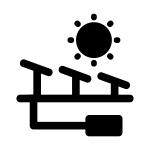There are hundreds of people living in Ngongo. Those lucky enough to live close to the well make around seven trips per day to meet all their household's water needs. But those who live far away from the well must stretch one jerrycan of water for drinking, cooking, cleaning, hygiene, and more, given that their trip takes more than two hours.
Ngongo's people once had to scrounge for water in dry riverbeds, digging scoop holes to reach salty, dirty water. And while the sand dam and shallow well we built in 2021 have improved things in the community for around 25% of the population, there are still too many who live kilometers away from the water source.
39-year-old farmer Jedidah Mathu finds it difficult to grow food for her family given the lack of water close to her home. She is shown in the photo below starting the long trek home from the shallow well with a jerrycan strapped to her head and back.

"I have to walk to this water point every day in the morning, which is time-consuming and exhausting," Jedidah said. "I find little time to focus on other activities like farming or rearing my goats. Fetching water to irrigate my crops is difficult because the water point is about two kilometers from my home."
Because of the hilly area in which they live, people must carry jerrycans on their backs rather than using stubborn donkeys to help ease their journey.

"Getting water to perform my personal hygiene is hard because water is sparingly used at home," said 17-year-old Faith M (fetching water in the above photo). "I also have to help my parents in fetching the water. Thus, I have little time to play with my friends."
With a solar kiosk that will bring water closer to their homes, Faith and Jedidah will be better able to tend to their own needs with water and have time to spare.
What We Can Do:
Our main entry point into this community has been the local Self-Help Group, which comprises households working together to address water and food scarcity in their region. These members will be our hands and feet in constructing water projects and spreading the message of good hygiene and sanitation to everyone.
Solar Water Distribution
This solar water distribution project will be built adjacent to one of our completed sand dam projects, which supplies clean drinking water to multiple surrounding communities. Given that the water source is still kilometers away from the farthest households, the solar distribution project will bring clean water closer to families who need it.
Solar-powered water distribution projects use solar energy to pump water from sand dams to elevated locations within villages to enable further water distribution and access within the communities. The water is pumped to storage tanks at an elevated platform and then connected to a water kiosk, where the water is collected from taps.
Hygiene and Sanitation Knowledge
As we have worked with this Self-Help Group already, we will hold refresher hygiene and sanitation training sessions to address essential hygiene practices and daily habits that need improvement. This training will help to ensure that participants have the knowledge they need to make the most out of their new water point as soon as the water is flowing.
One of the most important topics we plan to cover is handling, storage, and water treatment. Having a clean water source will be extremely helpful, but it is useless if water gets contaminated when it is consumed. We will also emphasize the importance of handwashing.
We typically work with self-help groups for 3 to 5 years on multiple water projects. We will conduct follow-up visits and refresher training during this period and remain in contact with the group after all of the projects are completed to support their efforts to improve sanitation and hygiene.
All of these components will work together to improve living standards here, which will help to unlock the potential for these community members to live better, healthier lives.




 Solar Pump
Solar Pump
 Rehabilitation Project
Rehabilitation Project























